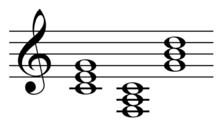Primary triad

In music, a primary triad is one of the three triads, or three-note chords built from major or minor thirds, most important in tonal and diatonic music, as opposed to an auxiliary triad or secondary triad.
Each triad found in a diatonic key corresponds to a particular diatonic function. Functional harmony tends to rely heavily on the primary triads: triads built on the tonic, subdominant, and dominant degrees.[1] The roots of these triads begin on the first, fourth, and fifth degrees (respectively) of the diatonic scale, otherwise symbolized: I, IV, and V (again, respectively). Primary triads, "express function clearly and unambiguously."[1] The other triads of the diatonic key include the supertonic, mediant, sub-mediant, and leading-tone, whose roots begin on the second, third, sixth, and seventh degrees (respectively) of the diatonic scale, otherwise symbolized: ii, iii, vi, and viio (again, respectively). They function as auxiliary or supportive triads to the primary triads.

In C major these are:
- I C
- V G
- IV F
- vi Am
- iii Em
- ii Dm
- viio Bdim
In a minor key triads i and iv are minor chords, but in chord V the leading note is generally raised to form a major chord.[2] For example, in A minor the primary triads are Am, Dm and E. Chord v (minor) in a minor key may be considered a primary triad, but its use is rare in common practice harmony.

Auxiliary chords may be considered parallel and contrast chords derived from the primary triads. For example the supertonic, ii, is the subdominant parallel, relative of IV (in C: a d minor chord is the subdominant parallel, the subdominant is an F major chord). Being a parallel chord in a major key it is derived through raising the fifth a major second (C of F–A–C rises to D → F–A–D, an inversion of D–F–A). Alternatively, secondary triads may be considered ii, iii, and vi.[3] In C major these are:[3]
- ii Dm
- iii Em
- vi Am
In A minor these are:[3]
- iio Bdim
- III C
- VI F
See also
Sources
- 1 2 Harrison, Daniel (1994). Harmonic Function in Chromatic Music: A Renewed Dualist Theory and an Account of its Precedents, p.45. ISBN 0-226-31808-7. Cited in Deborah Rifkin. "A Theory of Motives for Prokofiev's Music", p.274, Music Theory Spectrum, Vol. 26, No. 2 (Autumn, 2004), pp. 265-289. University of California Press on behalf of the Society for Music Theory
- ↑ Eric Taylor (2009). Music Theory in Practice Grade 4, p.22. ISBN 978-1-86096-945-4. ABRSM
- 1 2 3 Lancaster & Renfrow (2008). Alfred's Group Piano for Adults: Student Book 2, p.77. ISBN 0-7390-4925-9.